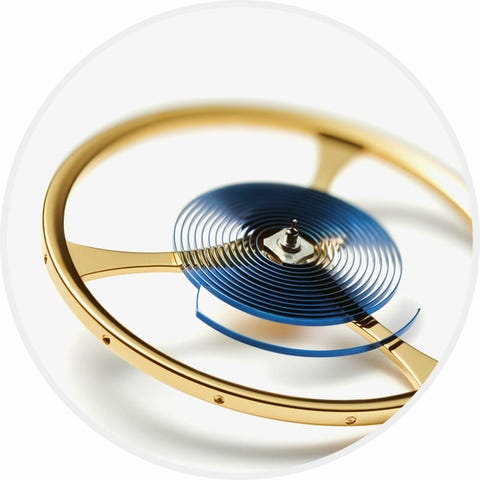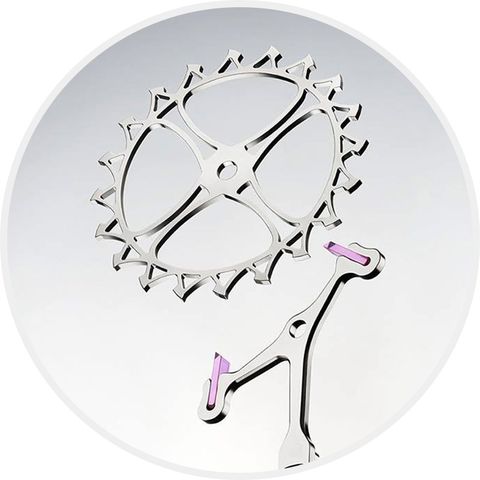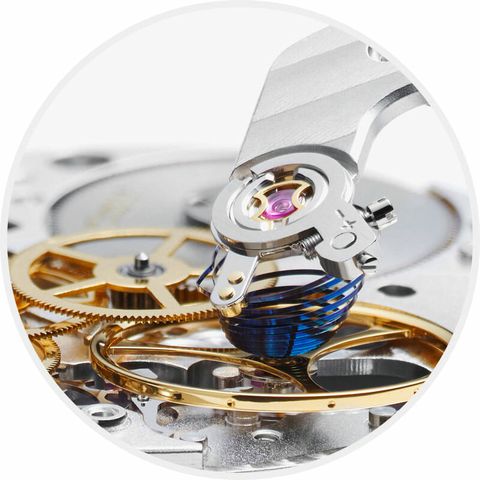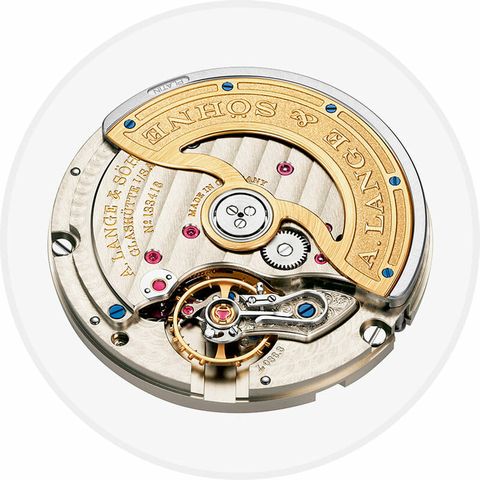How Long Does It Take for a Watch That Hasn t Been Used to Start Up Again
Congratulations, yous bought your first mechanical watch. That makes you the rightfully proud owner of more than just a timekeeper: that little disc on your wrist is an keepsake of the culmination of art and science, a salute to human being'south ingenuity. Whether yous wear it but for special occasions or it accompanies you during all of life'southward significant moments — and whether you paid a week'southward bacon for it or a yr's — it should serve you well, running trouble-complimentary for many years. Set it and forget it. Strap information technology on and get. These are the pros of a mechanical watch.
But before you reap the benefits, there are a few things to continue in heed that volition help keep that lookout man running flawlessly until you pass it on your offspring i day. Take some fourth dimension to learn them thoroughly. Your timepiece deserves information technology.
How a Mechanical Scout Works
The basic architecture of nearly every mechanical lookout man for the past iii centuries is the same, proving what a truly ingenious and efficient machine information technology is. Unlike a quartz watch, a mechanical timepiece doesn't get its free energy from a battery. Instead, the power that drives the easily effectually the dial, and too drives any additional complications like a date role, a moonphase or a chronograph, comes from the unwinding of a tightly coiled apartment spring.
Left unchecked, this mainspring would speedily unwind and give upwardly its free energy in an instant. Therefore, the butt that houses the mainspring meshes with a precisely-sized geartrain of toothed wheels that terminates in what is called the escapement. The escapement consists of a wheel that is caught and released intermittently by a pivoting lever. The pivoting of the lever is controlled by a frail screw aptly known as the hairspring. This so-called "lever escapement" controls the energy release from the mainspring, feeding dorsum this power through the geartrain, driving the hands of the watch to count out seconds, minutes and hours.
The hairspring is the heart of the scout; if you've seen a mechanical watch motion running, you'll appreciate that metaphor, every bit the hairspring "beats" back and forth at a steady rate anywhere between eighteen,000 and 36,000 times per hour. The precision of the lookout depends largely on the tension of this hairspring, equally well as its resistance to temperature changes and magnetism. Virtually modernistic hairsprings are made up of a metal blend that compensates for temperature changes, and some are made from silicon, which is immune to magnetism.
With all of these meshed gears and frail springs, information technology's a wonder these contraptions are as precise as they are (though a well-adjusted chronometer-grade move can go along time to a 99.999% accuracy). But, as you might judge, friction and external shocks are archenemies of the mechanical scout movement. Friction is mitigated by regular lubrication and shine "jeweled" bearings. Those ruby-red shiny discs you come across in the bridges of a sentry are rubies, formerly real ones, currently about often constructed ones. The pivots of the gear wheels ride in the center of these rubies, which are polished smooth to provide near frictionless surfaces.
If there were no wiggle room for those delicate pivots, a sudden jolt from say, your arm scrambling eggs, could shear one off, a death blow to the movement. So the jewels are suspended in a floating frame that absorbs vibrations and shocks, saving the pivots from certain decease.
How to Wind and Ready a Watch
One of the beautiful things well-nigh a mechanical spotter is that it requires interaction with its possessor to role. That coiled mainspring volition just provide power for a twenty-four hour period or two (or sometimes longer) if you don't go along it wound. A paw-wound watch is the purest form of the mechanical timepiece, which is part of its appeal. The mainspring is wound, as the proper name suggests, by turning the watch's crown a few dozen times. While winding a watch is a simple process, there are a couple things to be enlightened of.
Have It Off
Outset of all, wind the picket off of your wrist. While it may be tempting to give the crown a few twirls while you're surfing the Spider web at work, the angle can exist awkward and put lateral stress on the frail winding stalk. Secondly, don't overwind your watch. You'll know when it'southward wound when you lot tin't plough the crown anymore. This isn't similar topping off your gas tank (which you also shouldn't practise), and then don't attempt to requite it a niggling extra. Terminate winding when you first experience resistance. Try to wind your sentry once a twenty-four hours. A picket typically keeps the best time when the mainspring is higher up half tension. The typical watch has about a 2-day power reserve so winding information technology upwards before you strap it on each morning is a good addiction to course.
Let the Watch Practise the Winding
The automatic (or "self-winding") watch functions equally its proper name suggests. Equally long as you're wearing it, the mainspring maintains tension thanks to the weighted rotor in the movement that oscillates with your arm'south movements. A slipping clutch prevents the jump from getting overwound. Unless yous don't wear your sentry daily or yous're an extremely inactive person, y'all won't take to wind your automatic.
But if you practice, just give the crown twenty or 30 spins until the seconds hand starts moving, set the time and and so strap information technology on. Different the manus-wound lookout, you can't overwind your automatic, but don't overdo it — the winding mechanism in an automated is typically less robust than that in a paw-wound sentry and thus more vulnerable to breaking with careless or excessive utilise. Let the watch wind itself.
Get Ready
Setting a watch is a pretty straightforward process, simply information technology does have some dos and don'ts. The nearly important rule is not to ready the date if the watch's time is between ix p.thousand. and 2 a.thou. Note that we said "the watch's time", non the actual time of day. If you lot pick up a watch that isn't running and you lot aren't sure when it stopped, pull the crown all the manner out and spin the hands until the date changes. So y'all've found midnight; adjacent, accelerate the time past 2 a.k. before pushing the crown in to prepare the date.
Why, you inquire? The engagement-changing machinery starts to engage the gear train afterward ix p.chiliad. and but disengages after 2 a.grand. Setting the date during this menstruation can break off the fragile teeth of the machinery, resulting in a plush repair. It's also a skillful idea to ready a watch forward rather than running it backward. This is, once again, to preclude damage to the date mechanism. Of course, if your scout doesn't brandish the date, none of this matters.
Things to Avoid
Watch Your H2o Resistance
As nosotros mentioned above, the mortal enemies of a mechanical lookout man are moisture, shock and magnets. Fortunately, modern timepieces are pretty good at resisting all three. Synthetic gaskets, spiral-down crowns and tight tolerances keep water out of a sentinel — assuming they're all in skilful shape. Virtually watches, fifty-fifty dress watches, are rated for water resistance to at least 3 atmospheres, which is equivalent to roughly 30 meters.
That may audio deep, only it's nearly the minimum rating for a lookout man, and so though your Patek Calatrava will probably survive a dunk in the pool at a available party, we don't advise taking it for your daily morning swim. (For that, stick with a timepiece rated to at least 50 meters.) While screw-down crowns are the best insurance against moisture, even some 200-meter rated dive watches use robust double-sealed complimentary-spinning crowns. Regardless, if you spend a lot of time in the water (by pick or by accident), it's a good idea to take your watch'southward water resistance tested annually, and to have gaskets replaced.
In for a Shock
While the Incabloc and Kif shock absorbers in watch movements do a decent job of fending off life's unexpected blows, go on in mind that y'all are wearing a delicate precision mechanism on your wrist. We're known to bailiwick our watches to a off-white amount of punishment, but in that location are limits. Splitting woods, freeing a frozen bolt or golfing are activities for which a mechanical watch is non ideally suited. These occasions are perfect opportunities to strap on that quartz watch y'all've been neglecting and to leave the Speedmaster on your dresser — no matter how much testing NASA did.
Be Mindful of Magnetism
Magnetism can crusade the spirals of that delicate hairspring to "stick" together, shortening the bound and causing the watch to run very fast. Lookout man companies are making great strides in protection against magnetism, but the hairspring in most affordable mechanical watches remains vulnerable. Televisions, speakers and iPads all contain magnets that tin can affect the precision of your watch if you keep them in close proximity. If one day you find your normally reliable Breitling running five minutes fast, odds are it got zapped. Fortunately, demagnetizing is an piece of cake fix, and one a watchmaker tin can do in less than five minutes. Still, preventing magnetism is fifty-fifty easier.
How to Maintain Your Spotter
Polish That Crystal
Simply a niggling attention and TLC will ensure that your pride and joy withstands daily vesture and tear long plenty to pass downwardly to your heirs. About watches nowadays have sapphire crystals, which shrug off knocks and resist scratches. Yet, some timepieces (like the Omega Speedmaster Professional and the Panerai PAM00372) have acrylic crystals in keeping with their retro aesthetics; or maybe you're wearing Grandpa's 1960s Rolex Datejust with its warm plastic dome. While acrylic tin exist a scratch magnet, it can besides easily be polished. Car headlamp lens cleaner works; and so does Brasso. If y'all want to exist official, you can pop for a tube of Polywatch, which was designed for the job.
In This Case
Watch cases too go scratched unless your timepiece is a safe queen. Again, a little skillful polishing goes a long fashion. Invest in a lookout polishing kit, which will include abrasive cloths in varying grades of fineness, to restore various finishes. In a pinch, a skillfully-wielded Scotchbrite pad volition return your brushed Submariner bracelet to its original glory, though don't quote us on that. If yous have a collectible vintage watch, proceed in mind that original unpolished status may be desirable. In this instance, live with the scratches unless you lot don't intend to sell the watch.
Launder It Off
Regardless of the watch you lot wear, if it spends any time on your wrist, expect it to collect enough of your DNA to rival a criminal offense scene. So don't forget to clean it from time to time. An old toothbrush and some running water, particularly on the caseback and effectually the strap lugs, will keep your lookout nerd buddies from getting sick when they ask to see your classic.
Strap It On
Straps and, to a lesser degree, metallic bracelets, are the more disposable components of a sentinel, merely with regular care you lot can go along them looking good quite a fleck lot longer. Safe straps are durable and great for wet wear but tin degrade from exposure to the dominicus and from the application of bug spray, cologne and sunscreens. And then keep them rinsed-off and cheque for tears around the buckle and springbars regularly, lest yous lose your Seamaster to the briny deep when you least expect it.
Leather straps don't like h2o, but applying some leather oils and waterproofing products can protect long enough to go a few years out of them. With some simple polishing, a metallic bracelet should terminal every bit long as your watch. No affair what you choose, keep a few extra sets of springbars around and a quality strap-changing tool (larn how to apply information technology), peculiarly if you similar to swap straps often.
Spa Treatment
Everyone has heard stories of Rolexes and Seikos that lived through 'Nam on the wrist of a Navy SEAL, and then kept ticking in perfect time through subsequent decades of daily wear without maintenance, only this doesn't mean it'south proficient for the lookout. Every bit lubricating oils dry upward, gear teeth and jewels wear out; this tin can cause what normally would be a routine service to become a major (read: "expensive") overhaul.
Most modern watches tin can become for a adept five years before needing a visit to the spa. Given that, worn regularly, an escapement will encounter 700,000 oscillations per day, don't you retrieve a visit to a watchmaker twice a decade is well deserved? Watch maintenance can exist expensive, but a mechanical watch is an investment — chances are, if you've kept it that long, it's something yous value and want around a lot longer. So bite the bullet and send it in. Anyhow, it's a skillful excuse to buy some other watch to tide you over while it'south being serviced.
This content is created and maintained by a tertiary party, and imported onto this page to aid users provide their email addresses. You lot may be able to find more information well-nigh this and similar content at piano.io
Source: https://www.gearpatrol.com/watches/a467603/mechanical-watch-maintenance-guide/




0 Response to "How Long Does It Take for a Watch That Hasn t Been Used to Start Up Again"
Post a Comment